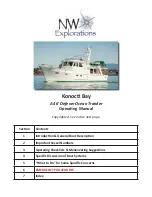
54
situations, it may be desirable to re-prop your Pro-Line to enhance the desired performance needs for your area.
For instance:
Decreasing the pitch will enhance acceleration and power at high loads.
Increasing the pitch will increase speed at light loads.
Decreasing the diameter will compensate for any loss of power at high altitudes.
Increasing the diameter results in higher efficiency at low speeds at the expense of top end speed
and acceleration.
Be sure not to over rev the engine when re-propping or engine damage could result. Operating your engine with
a damaged prop will decrease performance, increase fuel consumption, and may introduce undesirable handling
characteristics. The vibration caused by running a damaged prop could cause costly damage to your lower drive
unit.
Starting
Follow the information in your engine manual if it deviates from the following instructions.
Before Starting the Engines:
Ventilate all enclosed spaces.
Visually inspect the bilge for fuel and check for vapors.
Visually make sure that the propellers are clear of obstructions or swimmers.
Make sure that the engine cooling water intakes are submerged.
Lock the helm seat to face straight forward.
Attach the safety stop switch lanyard.
Starting the Engines:
Start the engine according to the instructions provided in your engine manual.
After Starting the Engines:
After your engine starts, make sure to observe a few basic rules to insure the engine is functioning properly:
Verify engine cooling water circulation.
Check the temperature gauge for the first few minutes to make sure the engine is warming
properly and not overheating.
Check for fuel, oil and water leaks. If any leaks are found, shut down the engines and make the
necessary repairs before continuing on with your voyage.
Follow the break-in procedures as recommended by the engine manufacturer for your engines.
Fueling
Certain precautions must be observed when fueling due to the explosive nature of gasoline.
















































